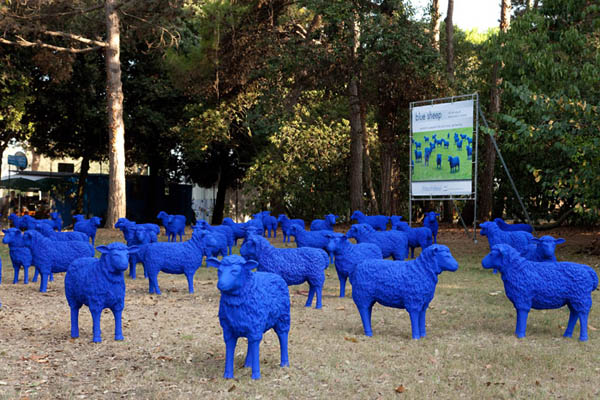Germany - Bertamaria Reetz and Rainer Bonk
Blue sheep: a flock of peace
Art as mild provocation, art as action, these are the pedals of a basso continuo that has accompanied Rainer Bonk’s work for years. In his campaign for social questions he is joined by a keen associate, the German artist Bertamaria Reetz who, from painting, to which she has dedicated a large part of her life, has now undertaken to spread Bonk’s message. The German artist, who started off as a designer, has become famous in Germany for his blue sheep. The blue sheep is a mild animal, which needs a green space to show off its bright coat to advantage; made of polyester, it does not fear inclement weather, nor even require feeding. It is nourished by curiosity, by interest, by the amused gaze of onlookers of all ages, when they see it grazing (in its own particular way!) in their meadows. But what is the message of this animal-object, of which hundreds of examples have been produced, gathered in flocks along the banks of the Rhine, in residential gardens and at the entrance of Museums? According to its creator, it aims to draw our attention to the environment. The artistic action of Rainer Bonk and Bertamaria Reetz has made a considerable contribution to environmental themes, usually backed up by a series of ventures involving institutions, scientists and lawmakers, citizens’ associations that care about the fate of the planet and that anxiously observe the deterioration of ecosystems on a global level which is accentuating the inequality among peoples and highlighting fundamental aspects concerning biodiversity and climate changes. For the two German artists, the responsibility for the impellent phenomena of desertification, which also threatens 51% of the soil in Southern Italy, does not lie only in the changes in climate and biological invasions, but also in the political system and in the egoism instilled in each one of us. From a flock, the blue sheep become a peaceful army, persistently inviting us to reflect and cooperate in the safeguarding of the environment. We all can and must act to halt this imminent death. The Blauschäfer Rainer Bonk - assisted by Bertamaria Reetz - launches an appeal that has all the strength of blue. Blue is the colour of lakes, seas and deep ponds. The water looks blue, but not because it reflects the sky: the longer the path of a beam of light passing through the water, the more the red and green of the solar spectrum are absorbed; instead the blue is reflected. Conversely, the more intense the blue, the deeper the water appears; so it symbolises our unconscious and seems to want to penetrate the deepest secrets of the soul. The old theory of elements linked water to a female principle, as opposed to the air, a male element. The virile element par excellence was fire, whereas earth was the most feminine of the elements, corresponding to all human humours. The phlegmatic humour was associated with water, its connotations were calm and passiveness, representing the female character of blue. The psychologist Eva Heller, who had initially associated blue with silence, passiveness and introversion, now breaks away from these stereotypes to confirm its inherent virility. This new choice takes us back to the tradition, introduced at the beginning of the twentieth century, of pairing blue and pink with the sex of newborn babies. That was a new stereotype that nourished business. But let us leave these discussions aside and return to the symbolic value of blue, confirmed by the father of psychoanalysis, Sigmund Freud, according to whom this colour takes us back to the source of religiosity, as it is permeated by a sense of universal union, of belonging to everything., Freud revisits the “perception of eternity, the sensation of something boundless, unlimited, oceanic” that he learnt from his friend Romain Rolland. Perhaps this oceanic feeling indicates the primal maternal attachment investigated by the Swiss psychologist Max Lüscher, in whose experience intense blue represents a philosophical-religious attitude of meditation, in search of an ideal unity. For Ingrid Riedel too, blue recalls the colour of the sea, the dark face of night: it is the colour of mysticism, of dreams, of the unconscious. Blue, which in these observations is associated with a range of positive values, may also conceal a perturbing component that the French call peur bleue, meaning the fear experienced when faced with the depths of the sea. Perhaps it is on account of this combination of opposing concepts with blue that we feel a sense of anxiety when we see that flock of peace arrayed on the lawns of the Hotel Des Bains, bringing to mind the Latin motto si vis pacem para bellum? The blue sheep invites us to action, an energetic action that frees us from the distress of an uncertain future for the generations to come. It stubbornly awaits a reply from our personal involvement.
Text by Nevia Pizzul-Capello
